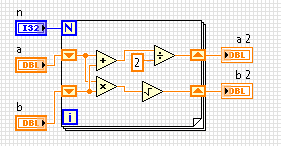这个问题的灵感来自于总部。
关于系列
这个问题现在是有关AGM方法的系列文章的一部分。本系列的第一篇文章将关于实际计算AGM。您可以像对待其他任何代码高尔夫挑战赛一样对待它,并回答它而不必担心系列赛。但是,在所有挑战中都有排行榜。
什么是算术几何均值
两个数的算术几何均值定义为反复采用算术和几何均值收敛的数。您的任务是在一些n迭代后找到该数字。
澄清说明
- 您可以
a, b, n采用任何合理格式的三个数字。 - 对于
n迭代,取算术和几何平均值a,并b与设置那些a和b。 - 对于两个数字
a和b,算术平均值被定义为(a + b) / 2。 - 几何平均值定义为
√(a * b)。 a并且b应该互相接近。- 然后,输出
a和b。 - 您不必担心浮动不精确等问题。
- 这是代码高尔夫球,因此以字节为单位的最短代码胜出!
测试用例
[0, [24, 6]] -> [24, 6]
[1, [24, 6]] -> [15.0, 12.0]
[2, [24, 6]] -> [13.5, 13.416407864998739]
[5, [24, 6]] -> [13.458171481725616, 13.458171481725616]
[10, [100, 50]] -> [72.83955155234534, 72.83955155234534]
The next one is 1/Gauss's Constant:
[10, [1, 1.41421356237]] -> [1.198140234734168, 1.1981402347341683]
排行榜
被马丁的系列偷走了。
以下代码片段将在该系列的所有挑战中产生一个排行榜。
为确保您的答案显示出来,请使用以下Markdown模板以标题开头每个答案:
# Language Name, N bytes
其中N是您提交的文件的大小。如果您提高了分数,则可以通过打败旧分数来保持标题。例如:
# Ruby, <s>104</s> <s>101</s> 96 bytes
a还是b “-”,哪个?两者还是其中之一?
